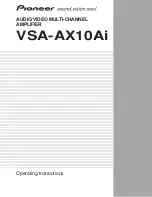
Connecting your equipment
02
13
En
7
Turntable ground
A grounding (earth) terminal for use with turntables that
require it. See
Connecting analog audio sources
on
page 22 for connection details.
8
Pre-amplifier output/power amplifier input
Do not remove the U-shaped connectors unless you plan
to connect an external power amp to this amplifier.
When using this amplifier as an integrated amplifier,
leave the pre-amp outputs connected to the power amp
inputs with the supplied U-shaped connectors.
Removing these connectors allows you to use this unit as
a pre-amplifier or power amplifier only, or to integrate
another amplifier into your setup for more inputs. See
Using the pre-outs
on page 77 for connection details.
9
Multichannel pre-amplifier outputs
Multichannel pre-amp outputs that you can use to
connect separate amplifiers for center, surround,
surround back and subwoofer channels. See
Using the
pre-outs
on page 77 for connection details.
10 Control input/output
Mini jack terminals for connection to other Pioneer
components to enable you to control all your equipment
from a single IR remote sensor. See
Operating other
Pioneer components with this unit’s sensor
on page 68
for connection details.
11 Monitor video outputs
Three video outputs consisting of a standard composite
video output and two S-video outputs, for connection to
monitors and TVs. See
Connecting your TV
on page 14 for
connection details.
12 Audio/video source inputs
Each of the seven source input functions has stereo
analog audio jacks, a composite video jack and an S-
video jack for basic connections. On top of these, you can
assign digital audio and component video jacks to input
functions as necessary. As well as audio/video inputs,
the three input functions
DVR/VCR 1
,
VCR 2
and
VCR 3
also have audio/video outputs for recording. See
Connecting a VCR or DVD recorder
on page 18 for
connection details.
13 Component video inputs/output
The three component video inputs are freely assignable
to any of the audio/video input functions. The component
video output is for connection to a monitor or TV. See
Using the component video jacks
on page 20 for
connection details.
14 RS-232C connector
This port is provided for connecting a personal computer
for graphical output when using Advanced MCACC.
15 12V trigger jacks
These terminals output DC 12V according to the input
functions (total 100 mA max.). See
Switching
components on and off using the 12 volt trigger
on
page 68 for connection details.
16 Speaker terminals
These are the main speaker terminals for front, center,
surround and surround back speakers. See
Installing
your speaker system
on page 24 for connection details.
17 AC power outlet
(Switched 100W max.)
This AC power outlet can be used to power another
component in your setup (up to 100 W). Power to this
outlet is switched off when the amplifier is in standby.
18 AC power inlet
Connect the supplied power cord here.
19 B speaker terminals
Stereo B speaker terminals that you can use to connect
a second pair of speakers for use in another room, for
example. See
Caution
on page 75 for connection details.
When making cable connections
Be careful not to arrange cables in a manner that bends
the cables over the top of this unit. If the cables are laid
on top of the unit, the magnetic field produced by the
transformers in this unit may cause a humming noise to
come from the speakers.
• When connecting optical cables, be careful when
inserting the plug not to damage the shutter
protecting the optical socket.
• When storing optical cable, coil loosely. The cable
may be damaged if bent around sharp corners.














































